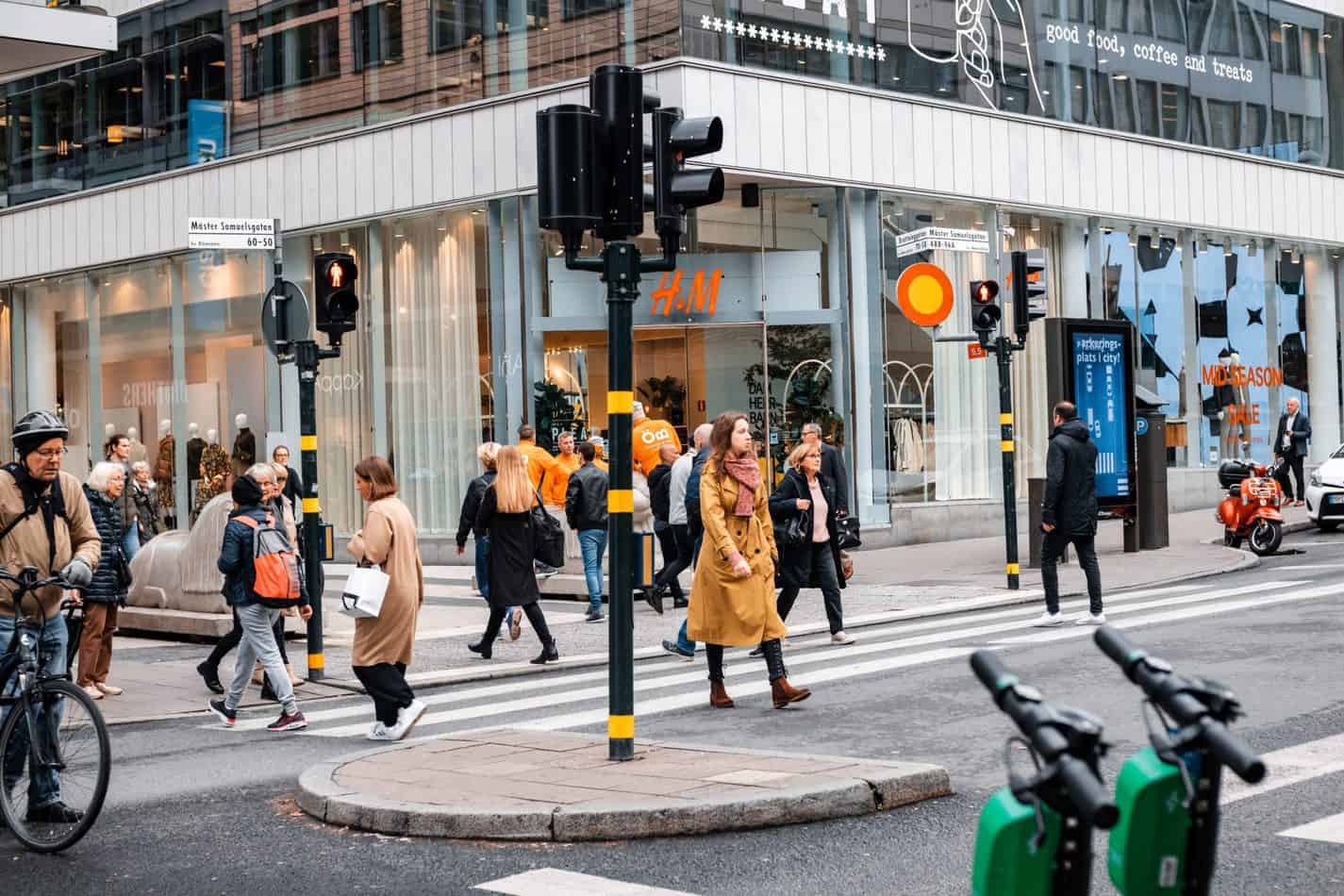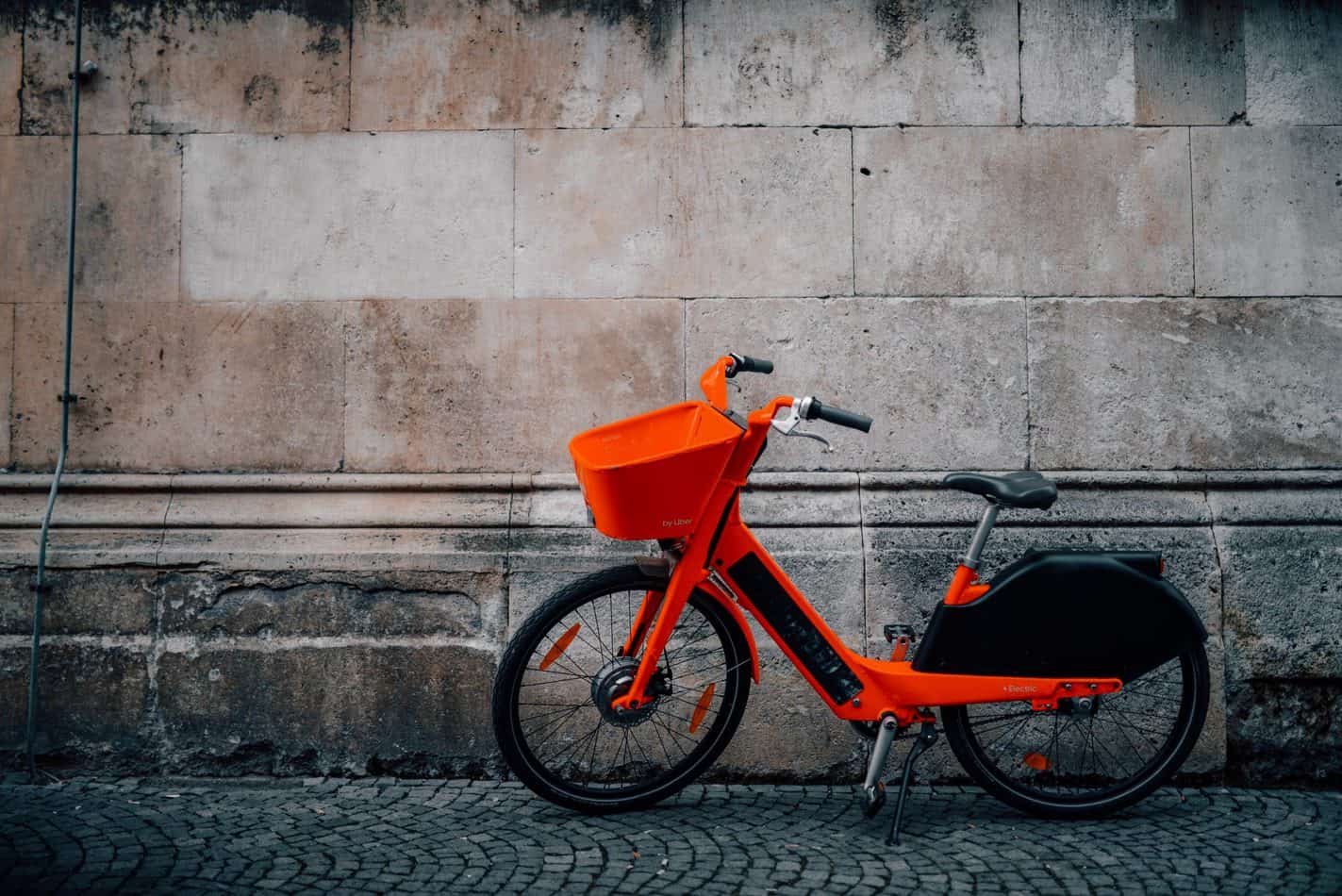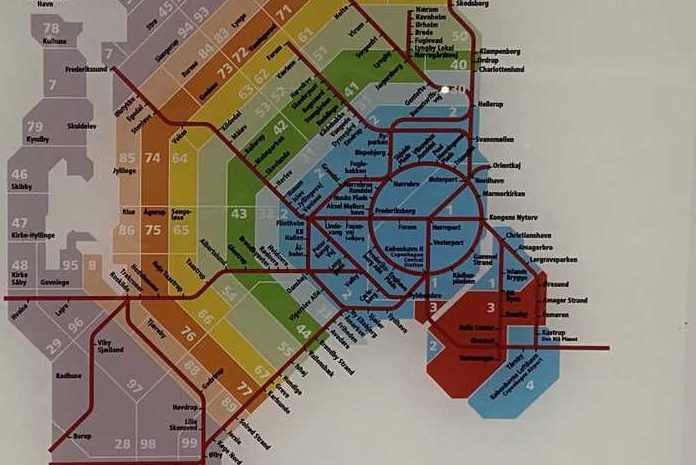
Arriving at a new city, the first thing one often think about is, how to get to the hotel from the airport and how to get around at your destination in general.
Some cities are easier than others to find your way in, some have a very compact city center, while others are spread out, making transport time longer. Some are almost impossible to walk around in, while others have very little public transportation.
Luckily Copenhagen is fairly easy to explore – both on foot, bicycle and with public transportation. Below I will cover the following questions, that might arise:
- Is it easy to walk around in Copenhagen?
- Is Copenhagen bike friendly?
- Is there Uber in Copenhagen?
- How much is a taxi in Copenhagen?
- How much is public transport?
- Traveling with children
- Where do you buy tickets?
- Using the City Pass
- Planning your trip
- Using the metro
- Can you buy tickets on the bus?
- Buying tickets at Copenhagen airport

Is it easy to walk around in Copenhagen?
Yes! Copenhagen is not that large a city, so if you have your good walking shoes on, you can actually cover most parts of it, since a lot of the tourist attractions are in the city center, which is less than 6m2 in size.
Unlike some larger cities, Copenhagen has sidewalks everywhere, typically on both sides of the streets. The locals walk (and bike) a lot, so the motorized vehicles are used to pedestrians, so you’re perfectly safe using your two feet to get around. Just follow these advise:
- Use the sidewalks at all times. If there isn’t a sidewalk, you’re probably not supposed to walk there.
- Typically, we have bike-lanes, just next to the sidewalks. So watch out for bikes – especially if you’re intending to cross the street.
- When you do want to cross the street, find a pedestrian crossing, where the cars and bikes for that matter, by law, shall stop to let you cross – but don’t just cross the street, expecting them to stop! Stand by the side, showing your intent to cross and they will eventually stop. If there isn’t a pedestrian crossing, find the nearest traffic light and wait for a green light.
- In Denmark we obey the traffic code, so don’t cross the street unless there’s a green light. You could risk a fine if you cross, when there is a red light.
- Remember to look in both directions before crossing the street. We do have some one-way streets in Copenhagen. This is especially important if you’re used to traffic driving in the left side of the road – which is opposite of Denmark.
Is Copenhagen bike friendly?
Absolutely! Just like we have sidewalks allover, bike paths are very common, especially in Copenhagen. The municipality of Copenhagen has invested a lot of money over the last years, to improve and expand the network of bike paths, so they can reach their goal of having 50% of the population, using their bike when going back and forth to work or school. Close to 700 km of bike paths are now in place, covering Copenhagen and suburbs (source).
At several metro and train stations and at other cycling hot-spots, you can even find stationary pumps, should your tire need a bit of air. If you’re bringing your bike on the metro or regional trains, remember to purchase a bicycle ticket. On the S-trains and harbor buses, your can bring your bike free of charge.
But just like when you’re exploring the city by foot, you should also take some precautions on bike:
- Use a helmet! I know that you don’t look very chic with one on, but it might save your life!
- Use hand-signals to tell people around you, what your intentions are. Hold out your arm to the side you intend to turn at a traffic light for example. When you are going to stop, let the ones biking behind you know, by holding up one arm, so it forms an L (or a reversed L, depending on which arm you use). If you see someone in front of you doing this, be ready to brake.
- Turn on your lights, when it’s dark. Then you can see where you are going, but more importantly, other people can see you. Failing to have lights on after sunset, will cost you 700DKK, should you get pulled over by the police… and this happens frequently.
- Don’t use your phone will biking. Most rental-bikes have phone holder on the handlebars – use it.
- Keep an eye on the traffic!

Rental bikes and scooters
A lot of descent hotels nowadays have bikes, you can borrow during your stay, but if yours doesn’t, there are numerous alternatives. You can rent bicycles at a lot bike shops in town. Otherwise, you will probably notice rental bikes and scooters parked everywhere.
These are just as easy to rent – just follow the instructions on the vehicle. You download the app of the company behind and set up an account, with your credit card and you are on your way in no time.
Is there Uber in Copenhagen?
No, not anymore unfortunately. There was very briefly a few years back, but it didn’t last long and they eventually pulled out, since they weren’t able to convince the politicians, that their business model lived up to all the Danish laws.
There has been some murmur of them returning, after they revised their model and now don’t have a “one-size-fits-all” approach to all countries they enter, but we’re still not able to book a ride through their app.
How much is a taxi in Copenhagen?
Well generally it is considered to be expensive to take a taxi in Copenhagen. It’s difficult to give an exact price, since the price varies from company to company and whether it’s during daytime or night or during weekends. The starting price during daytime is around 40DKK and then you pay at least 8DKK/km or at least 6DKK/minute.
If you’re riding the taxi during rush hour and you’re stuck in traffic, the meter will keep running and the price will quickly rise. A trip from the airport to city center won’t cost you less than 150DKK and probably more than 200DKK. Some taxis might have a fixed price going to and from the airport – ask when hailing the cab.
Wondering whether you should tip the driver? I recently wrote an article on tipping in Denmark – check it out!

How much is public transport?
In Copenhagen we pay 12DKK/zone you travel in/through. But the minimum number of zones you can purchase is two, so 24DKK is the cheapest ticket.
Our zones have numbers, which is just a number, so don’t let that confuse you. You can for example travel from zone 2 to 32, which are just next to each other, but you only need a 2-zone ticket, since you start your journey in 2 and end in 32.
See, you always count the zone you’re in and then the one you want to travel to. It’s pretty simple, if you just remember that.
But most tourist will never leave Zone 1, which cover a very large part of Copenhagen and the neighborhoods. It’s only when traveling to and from the airport, that you need a 3-zone ticket (36DKK), since you’re traveling through zones 1+3+4, depending on which direction you’re going.
A 2-zone ticket is valid 1 hour and 15 minutes, while a 3-zone ticket is valid 1 hour and 30 minutes. You can travel as many times as you like, during the time of validity, within the purchased zones.
Traveling with children
As an adult you can bring along two children under the age of 12 for free, when you have a valid ticket. Children between the age of 12 and 16 are half price of a normal ticket.
Strollers and prams are completely free to travel with and there are elevators at almost all stations, if the tracks aren’t level with the street. You can also bring them on the bus, since they lower themselves, when stopping at the curb. None or sometimes 1 step and you’re in the bus. The Danes don’t mind lending a hand, but sometimes you need to ask.
Where do you buy tickets?
You can buy tickets at the vending machines, which can be found at train and metro stations and you can also buy them at 7-Eleven.
You could also use the app made by the companies who run the trains, metro and buses. Search for “DOT Tickets”. Install and open the app and type in your phone number (it supports other country codes than Denmark’s). Now you can buy single tickets and City Passes (which you can read more about just below) in the app.
If you let the app use your location, it can even help you identify in which zone you are. Just press Buy Ticket and either search for where you want to go or press on the map and it will tell you what kind of ticket you need.
The tickets are valid for both train, metro and bus, no matter where you bought them.
Using the City Pass
If you plan to use the public transport a lot during your stay in Copenhagen, you should consider getting a City Pass. The pass lets you use the bus, train and metro for an unlimited number of times during a specified time period of your choice (24, 48, 72, 96 or 120 hours).
You simply buy the pass online and receive it by SMS on your phone (or in the DOT Tickets app) and you’re good to go. That way, you won’t have the hassle of figuring out how many zones your ticket needs to cover and buying them again and again.
The City Pass comes in two sizes – small and large. The small one covers the most of Copenhagen, including the trip to/from the airport and will be more than sufficient for most travelers. The large covers even more of Copenhagen as you can see on the map, if you follow the link to the vendor below.
The pass is only worth it, if you plan to use the public transportation quite a lot. The 24 hours small pass is 80DKK. But a ticket from the airport to city center is only 36DKK one-way. If you want to go a few stops by metro, it’s 24DKK, so that’s only 60DKK in total and you have to cover it within the 24 hours. So plan carefully, before deciding.
City Pass can be bought at the official vendor.
Planning your trip
When you’re in a new city, it can sometimes be difficult to figure out, which means of transportation you should choose. Which is the quickest and what about the price?
Google Maps’ app can definitely be helpful, but you can also use the excellent journey planner (in English) at www.rejseplanen.dk .
Here you enter where you are and what your destination is and when you want to go or arrive. Under the options tab, you can even choose if you only want to use the metro or if you want to add a stop on the way, plus other options.
It also comes as an app. Search for “rejseplanen”, since there is an app called Journey Planner, but it’s not the one you want.
Using the metro
The Danish metro system is fairly new – the M1 and M2 opened in 2002 and in 2007 you could go all the way to the airport. In 2019 the M3 opened and M4 is planned to open in 2020.
The metro is easy to use, but there just one thing I would mention: the newly opened M3 goes around in a circle, which isn’t a problem, but it means that there isn’t an end station, for you to navigate after, when to decide in which direction to go.
So, you have to check a map, so you have an idea on which stations are in which direction, since this will tell you what track to choose. Hope that made any sense.
Can you buy tickets on the bus?
Yes, you can pay when you enter the bus. Just tell the driver, either where you’re going or even better, how many zones the ticket should cover. The driver accepts cash, but don’t expect them to take bills larger than 100DKK.

Buying tickets at Copenhagen airport
When you arrive at Copenhagen Airport and have reclaimed your luggage, you will exit through customs and find yourself in terminal 3. If you keep walking straight after exiting customs, you come to the end of the terminal, which is one long building (shaped like a giant wing), so it’s pretty simple.
The photo above is from the baggage claims area, just next to the baggage belts. So, if your waiting for your luggage to arrive, have a look at the screens, to see when the next trains and metro depart and where to go after passing customs. The screen on the far right, probably does a much better job explaining it, than I tried to do above.
Anyway, in the far end of the terminal building, on your right hand side, there are several red ticket machines, where you can get the tickets needed for your onward journey, whether it be by train, metro or bus.
From here just follow the signs to either the train, metro or bus, which are only a few step away now. If you taking the train to city center, make sure you take the steps to the correct track (look at the TV monitors, to see which train departs from where), since one track is with trains departing for Sweden and the other with trains for Copenhagen and other parts of Denmark.
Typically the tracks closest to customs are the ones with trains for Sweden, but every now and then there will be an exception, so be sure to check your self.
